|
The trip to
North America consists of two races just seven days apart in
Montreal and Indianapolis and while, on the surface, there
would appear to be little in common between the quirky
Canadian Circuit Gilles Villeneuve, set on an island in the
St. Lawrence Seaway and the famous Indianapolis Motor
Speedway, where the Formula 1 cars race on part of the
legendary oval track, from a car engineering viewpoint they
share several similarities. Paolo Martinelli and John Iley,
respectively head of Engines and Aerodynamics for Scuderia
Ferrari Marlboro discuss the specific requirements of these
two demanding circuits.
PAOLO MARTINELLI
Both drivers will be starting Canada with new engines and so
they will have to deal with the demands of both North
American weekends. "In Canada you need a combination of good
aero efficiency, strong brakes and also a strong engine for
good acceleration," begins Martinelli, outlining the prime
requirements for the first of these two back-to-back
weekends. "In terms of severity on the engine it is quite
tough because there are frequent accelerations and a
significantly long straight. And with Indy following it, it
means we have two severe races one after the other - in this
third of the season probably the most severe pair in terms
of demands placed on the engine. We have put a great deal of
effort into preparation for these two grands prix, with
simulation on the dyno and track testing last week at Le
Castellet, with a major test involving the race and test
drivers and two cars. We did a long run to simulate as
closely as possible the behaviour of the engine in the
Canada and Indy races."
It will be the first time in many years that V8 engines will
be raced at these tracks. "But we have specific software
with which we can simulate complete car behaviour and so we
can predict the revs, gear ratios and car settings before we
get there," says Martinelli. "In addition, for the engine,
we can also simulate quite accurately the race to come on
the dyno. Specifically, comparing the V8 to the V10 from
last year, the period of wide open throttle will be between
10 and 20% higher and even the medium revs will be up by 6
to 800 rpm which adds significantly more stress to moving
parts in the engine such as pistons, valves and other
components."
With two tough races to deal with, Martinelli is naturally
cautious when pushed on the question of reliability. "At the
start of the season, we encountered an unexpected technical
problem with the new V8 engine which we had not predicted
from the results of winter testing," he admitted. "We
confronted this problem in the piston area, identified it
and fixed this issue. Apart from that, we have had no
significant problem in terms of reliability. Of course we
are trying to improve continuously in terms of performance,
even though the next two races are very severe. It is
impossible to say we are one hundred percent safe in terms
of reliability, because in Formula 1 the safety margin is
really tiny, a 2 to 3% margin only in order to maintain the
necessary level of engine performance. So our performance in
North America will also depend on the conditions we
encounter. There are several parameters. You can have a hot
race where you want to run at the front so that no other
cars impede the flow of air through your radiators. If the
competition is very strong then you have to push hard for
the entire duration of the event, from the first to the last
lap which produces additional stress for the engine. We have
to be prepared always for the worst case scenario. We have a
mileage target of around 600 kilometres per event, made up
of a 300 km race, plus qualifying and free practice, which
is then multiplied by two to complete both races."
However, there is little one can do to "preserve" engine
life over these two weekends. "Normally we can try and
protect the engines in terms of revs and temperature during
free practice on Friday and Saturday morning," says
Martinelli. "While working on car set up, the last two to
three hundred rpm are not vital. But in qualifying and the
race you cannot protect the engine unless you are in the
lead with a good margin, something we have not seen anyone
enjoy this season! Canada and Indy are both tough but it is
the combination of the two together that is the really tough
aspect. Both circuits are demanding. The peculiarities of
Canada, as I've said before are good efficiency and
acceleration and hard braking.
|
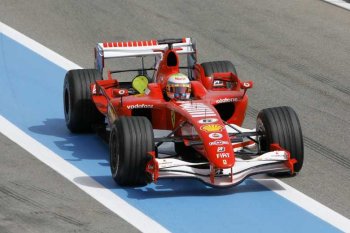
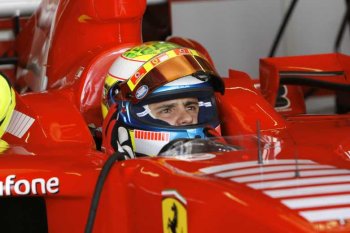
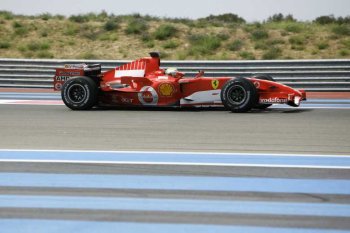 |
|
Felipe Massa testing
the Ferrari 248 F1 at the Paul Ricard HTTT track
last week. The Brazilian will go into his first
Canadian Grand Prix with the Scuderia. |
|
|
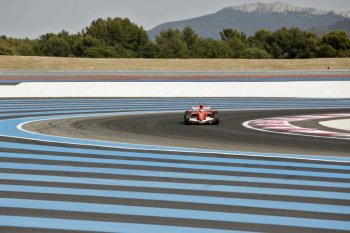

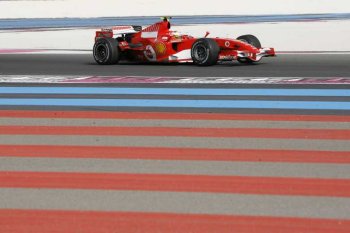 |
|
Luca Badoer testing the
Ferrari 248 F1 at the Paul Ricard HTTT track last
week. The Scuderia now face two races on consecutive
weekends in Canada and the USA. |
|
|
"Indy however, combines the aspect of the very long
straight with a banked corner so you keep the throttle wide
open for over 20 seconds, maybe we can expect 22 seconds of
full throttle, the longest of the championship. Then there
is the infield, where in engine terms, you can relax a bit.
Specific components, mainly the pistons, suffer from the
continuous long straight and that is the critical area. We
have prepared some new developments for these events which
we have tested in Ricard and from what we have seen there we
will introduce them as of the next race."
JOHN ILEY
Both Montreal and Indianapolis are circuits that require
what can be called a medium drag package, when it comes to
aerodynamics. "This involves a brand new rear wing assembly,
some extensive modifications to our existing front wing
assembly, refinements to the brake ducts, especially for
Canada, where the circuit places the highest demands of the
season on the brakes, so we have to be mindful of this,"
explains John Iley. With two less cylinders and a capacity
drop, one would expect the current crop of engines to
produce less power and therefore put less strain on brakes
and their aerodynamic requirements, but apparently this is
not the case. "With the V8 what is interesting is that
because of the tyre development so far this year, the grip
level has also increased quite a lot. Therefore, while we
expected that lower power would mean lower top speeds which
would affect the braking in a helpful way as we are braking
from a lower top speed, this has not happened. In fact, the
lower Cd level we can run is not helping in terms braking
from an aerodynamic point of view and then, if you add the
increased tyre grip, I think the braking distances and work
for the brake system are even tougher now than last year."
The most radical changes are to the bodywork and wings as
the aerodynamic package is generally optimised to suit the
majority of the tracks on the calendar. "Therefore, for
Canada and Indy you refine a lot of the areas so we have a
whole new bodywork package as well. This was planned from
before the start of the season, because I would estimate
that 90% of this new package is circuit specific, with only
the remaining 10% coming from our ongoing development and
what we have learnt so far this season. We are really
refining the car package for the two North American races.
The biggest difference between these two tracks is the
braking. The reason we can run lower drag is that at both
circuits there is an absence of true high speed corners.
Canada has a lot of chicanes, which put more of a premium on
braking, stopping and change of direction. Indianapolis has
one very high speed corner that is not demanding in terms of
aerodynamics and is quite easy to drive flat out. It then
has quite an arduous infield section which does not put much
of a premium on the aero side. In this case, we are looking
at reducing the drag, helping stability of the car under
braking and having a good braking system."
The theoretical advantages of the car's aero package have to
work in the real world on the track and at the races, it is
up to the race engineers to use it as best they see fit. "We
provide the aero range which the team can operate in during
the weekend and then, in Indy for example, it's up to them
to decide if they want to be lighter on downforce to be
faster on the high speed section and compromise the infield
or if they prefer to be the other way round. There are some
areas where we can refine the behaviour of the package in
terms of being good for both parts of the track, but that is
just in small detail. This year we have had a big push on
the overall efficiency of the car and I am happy to say that
is reflected in the speed trap figures over the year so far
and reflects on a very good job the department has done.
That helps, as it means the compromise can be minimised as
you can run high downforce for the infield section and still
have very good straightline speed."
|
|
|
|
![]()
![]()